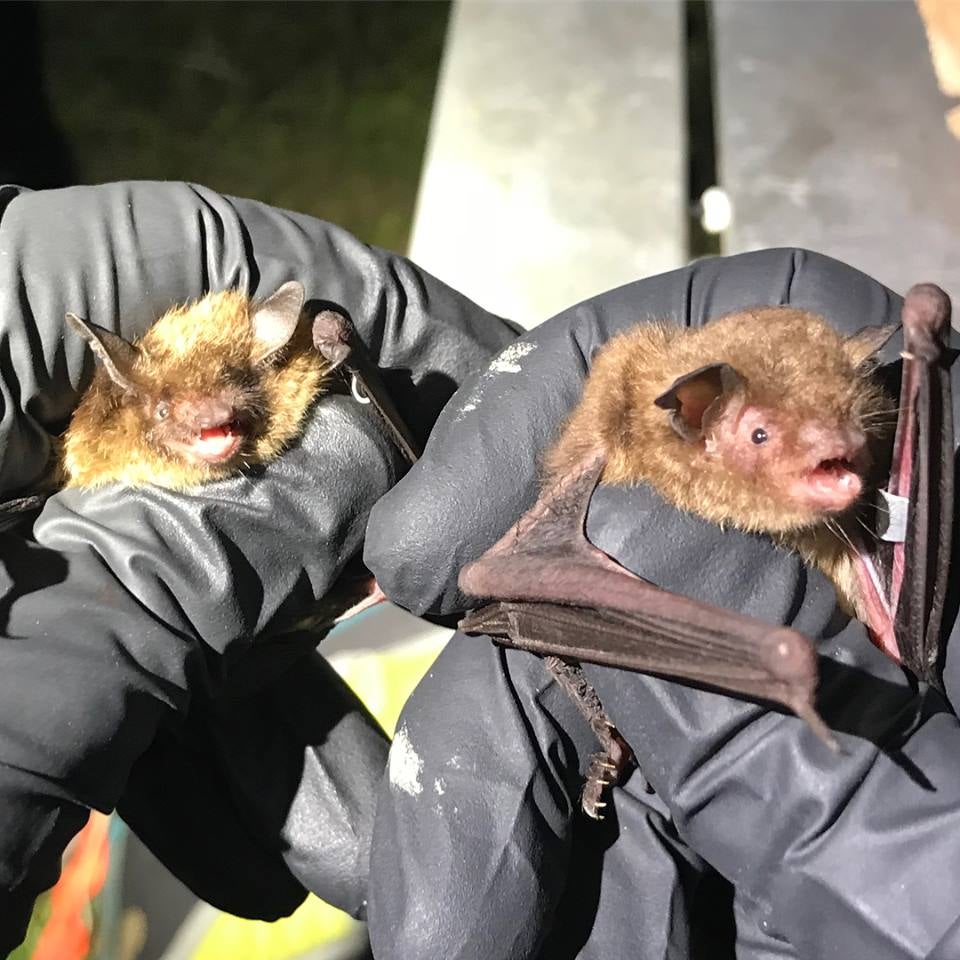The good, the bat and the rabies: Animal control encouraging anyone with a bat in their home to get it tested, but not all bats are bad news
Published 6:41 am Saturday, August 18, 2018

- Photo courtesy of Copperhead Environmental Consulting Inc. The little brown bat, left, and big brown bat are the two most common bat species in Kentucky. They are seen as a benefit to ecosystems due to their massive bug consumption, helping not only rid areas of mosquitos, for example, but helping to protect crops.
Helen Palmer thought she was doing the right thing when she had a bat caught and released that found its way into her home. But after a quick call to animal control, she found out she she may have been wrong.
Palmer has lived on Broadway here in Danville for more than 70 years — since 1946. At one point, a contractor had found four bats living in her attic a few years back, which is a common occurrence. However, those familiar with the habits of bats say finding them inside of areas other than attics of the home is unusual. Last year, one materialized in Palmer’s downstairs, she said, which was also caught and released.
The most recent incident led to her finding out her neighbors across the street had dealt with an even bigger bat problem.
“Saturday evening, I was sitting at my desk working in my bedroom, was actually on a business call and I said, ‘Oh my goodness, there’s a bat in here …’” She’s got 12-foot ceilings in her home, so it was flying high at the top for a while, but eventually swooped down and almost hit her dog.
“My dog sat up and looked at me like ‘what am I supposed to do?’ Then it flew up again, came around and swooped down toward me — I ducked! It was that close.” Palmer did get it outside of her bedroom without touching it, where it ended up in her dining room drapes. A friend came over to help her get it out of the house, who told her it appeared to be a baby bat.
“And where there’s a baby bat, there’s usually a mother bat,” Palmer said. She’s been told mother bats don’t allow their babies to go off on their own when they’re that little, but it still had a good-sized wingspan, about 10 inches. Her friend got it into a can and took it out on the street to release it, but it wouldn’t fly away.
“At first, it wouldn’t get out of the can, until she turned it around, straight toward the house across the street,” Palmer said, then it immediately flew toward it. Neighbors were out front of the home who told her she must’ve caught “one of our bats,” as they had recently caught and released 15 of them from inside the home. Palmer said they told her they took the bats to release out in the country.
“John (Hamblin, director of animal control) was just horrified” when he learned the bats were being released, Palmer said. “But if no one knows what to do in this situation …”
“I just found out about it this week” about the catch-and-releases, Hamblin said. So far, those are the only two households he’s heard about having bats inside of them.
“I heard they had 15 of them, and I thought oh gosh! Anytime there’s a bat in the house, and if you’re laying down and sleeping, you could get bit by it and not even realize it.”
Hamblin said anytime animal control is called to remove one from inside of a dwelling — which he said is not very often — they collect it and send it off for testing. But in this particular case, at this particular time, Hamblin was more concerned due to reports of rabid bats recently out of Lexington.
“In the last three months, we’ve had about three bats test positive for rabies,” said Skip Castleman, environmental health coordinator with the Lexington-Fayette County Health Department. He said one was brought in from the Cumberland Hills subdivision, and one from Lakeview Acres, both in the southern part of Fayette. The third was from the Radcliffe/Marlboro neighborhood, in the northern part of the county. The department posted signs in neighborhoods to notify residents of the discoveries.
The people involved, who could have come into contact with the bats, all had to go through rabies prophylaxis — post-exposure vaccinations for rabies.
“It’s not a cheap process to go through,” Castleman said, estimating the shots cost about $5,000. He said there have been no reported cases of humans affected with rabies in the state that he’s been made aware of.
Castleman said unless small children are in the household, or if anyone reports the possibility of contact with the bat, he wouldn’t automatically say the bat should be sent off for testing; it depends on the household situation.

Photo courtesy of Copperhead Environmental Consulting Inc. Gregg Janos, a bat biologist with Copperhead Environmental Consulting Inc., a firm in Garrard County, holds a hoary bat. Janos is one of the biologists on the job for the consutling firm when a company needs to analyze habitats of bats in a certain area where tree removal is being considered.
“If they were handling the bats — they have needle-like teeth, so someone can get bitten by them fairly easily and not feel it, they have such a fine tooth.”
Also, children are more apt to sleep through a bat bite than adults.
“Most adults would wake up if something landed on them in the night; a child might not,” he said.
If someone drinks alcohol or takes sleeping sedatives before bed, they may not wake up either. But, Castleman said, if bats are found and there’s no situation where people would have had possible contact or small children in the home, there’s really no reason to get them tested.
“I would question any type of situation (when a bat is found) to find out. Some people can confirm without a doubt there was no exposure.”
When they are brought in, bats are sent to a state diagnostic lab, where the brain tissue is tested.
When rabies is detected, Castleton said the media is notified, and then the calls start coming in. “Some people will see them outside and call us to come get them.”
But bats aren’t a bad thing, usually — “The ones in the wildlife do a lot of good stuff, they eat about twice their weight in bugs …” he said.
The Lexington health department release also said residents can prevent bats from entering homes by carefully examining their houses for any holes that might allow them in. Any openings larger than a quarter-inch by a half-inch is large enough for a bat to enter through. The openings should be blocked either with stainless steel wool or caulking in the fall or winter, to avoid unintentionally trapping bats inside a house.
Common ways for bats to enter include through chimneys, vents and openings behind shutters, as well as under doors, siding, eaves or shingles.
“If there’s a way they can get into the attic, that’s pretty common, but usually they don’t get into a house where there’s a lot of noise,” Boyle Animal Control Director Hamblin said. “Mostly it’s homes that are quiet or not sealed very well — they don’t need a very big hole. They’re like a mouse with wings.”
Bat biologist Gregg Janos wouldn’t characterize the flying mammals that way.
“I’m not a big rodent fan — I think bats are cuter and nicer-looking than mice,” said Janos, who works for Copperhead Environmental Consulting Inc., a firm companies hire to review habitats in a wooded area, for example, if they are planning on constructing something through it, like a pipeline. The company also does research via grants to collect more information on bats in order to hopefully help certain species that are endangered.
Janos said first off, any mammal species can have rabies. He said the main reason bats get such a bad rap is normally, if bats make the news, “It’s usually because of a rabid bat, so people think they’re a large cause of rabies.” But actually, less than 1 percent of bats have rabies, he said.
Bats are one of the most diverse groups of mammals in the world, Janos said. “There are a lot of species. In the eastern United States, I think there’s 17 species.” All of the ones in the eastern United States exclusively eat insects. Vampire bats, which will feed on livestock, don’t live here.
When it comes to bats being inside man-made structures, Janos said it’s typically one of two species: little brown bats or big brown bats.
“Pretty much they are the only two — every now and then you’ll get a few others. They’re generalists; not really picky about where they roost. If they can get up into the rafters of a barn or an attic, it’s suitable for them.”
Part of the reason they are being found in more structures like this, Janos said, is due to their summer habitat being lost to deforestation.
“Many species roost under the exfoliating bark of standing dead trees. If they can’t find a suitable tree, certain ones — like the little brown and big brown bats in particular — may move into man-made structures like houses or barns.” He said many species are social and like to roost together when raising pups.
Bats don’t have any reason to want to be around people, Janos said, but rabies causes them to act out of character. “They will either be roosting in areas that they typically wouldn’t be, flying around during the day or less fearful than they’d normally be.”
As far as bats mostly wanting quiet places, Janos said he can’t really speak to that.
“They really don’t seem to be overly deterred by human activity, but if there’s a lot of noise going on non-stop, maybe. But if they’re up in an attic that’s rarely visited by anyone, if they can get in, they wouldn’t be deterred if people live in the house.”
He said there’s no reason for a bat to interact with a person unless it has something wrong with it.
“White nose syndrome alters their behavior too, because they are malnourished and dehydrated,” he said.
The disease is caused by a fungus that affects hibernating bats. But that only influences their behavior in the winter, he said. The fungus causes them to wake up repeatedly and groom themselves more often, which uses up their energy and forces them to come out of hibernation to seek food and water. But, they’re not going to seek out humans by any means, he said.
“The only way you can get rabies is if an animal bites you, when the saliva gets under the skin,” Janos said.
Palmer said she didn’t want to make herself paranoid about the bat in her house, since she knew she had no contact with it.
“They’re so beneficial — I know this,” Palmer said, and pointed out a Going Green column in The Advocate-Messenger written by Amanda Wheeler about that very thing, and about how white nose syndrome is killing millions of them.
Wheeler, an environmental columnist with a master’s in zoology, said bats not only help keep the insect population in check, but are also big mosquito-eaters. What they consume not only benefits humans but crops, too. When bats are out eating, she said they can consume up to 1,200 mosquito-sized insects per hour.
She said three of Kentucky’s bats are listed as federally endangered, and one species is listed as threatened. Some not listed are still being threatened by white-nose syndrome.
“Bats really are unique and amazing creatures, being the only mammal that can fly. They don’t want to hurt people and would really rather not be near us,” she said.
While she loves bats, Wheeler said she doesn’t want them in her house, so she makes sure her screens on the windows and her doors are free of holes. She does other checks around the house and attic to make sure there are no tears or openings and the eaves are meeting up securely with no gaps.
“Bats are really beneficial to us and we can co-exist with one another,” Wheeler said.
Hamblin said if someone sees a bat in their house, they should not try to catch it themselves; they should call animal control instead.
“If they’re not up real high, we can get them pretty easily and remove them from the premises, and do what we need to do with them,” he said.
Due to safety issues, animal control officers can’t climb into attics or other dangerous places because they don’t want to bust through someone’s ceiling, but Hamblin said there are “critter control” companies out there who can do just that.
“Don’t try to touch them, especially if there’s kids around,” Hamblin said. He said they might think it’s cool to hold a bat, but if they get bitten, they’ll likely have to go through a series of rabies vaccines.
“We have a real standard procedure … and we have to send off the head of the animal to the state lab in Frankfort …” said Brent Blevins, director of Boyle County Health Department. “It wouldn’t matter what kind of animal it was, for that, if there’s any suspicion of rabies, that’s how it works.”
Blevins said the more information people have about rabies, the better — “whether it’s bats, dogs, whatever it is.”
He recommends checking out the Center for Disease Control’s information on rabies, at www.cdc.gov/rabies, which gives information on rabies and vaccinations.






